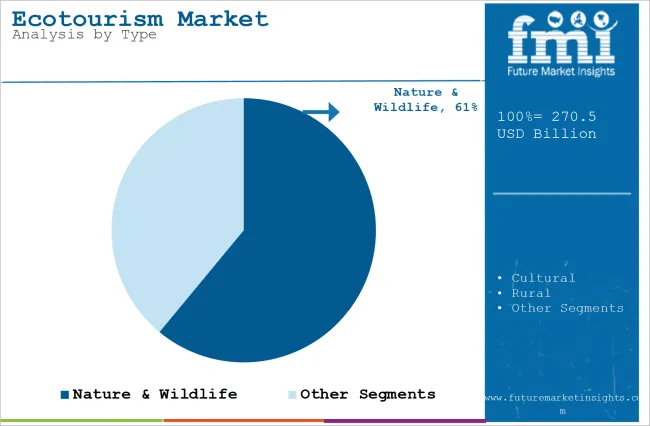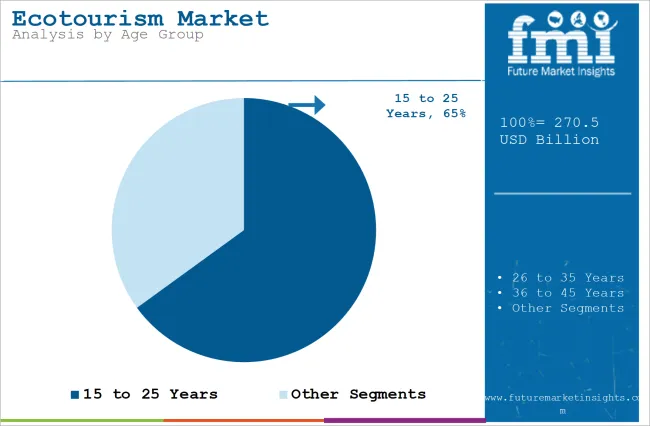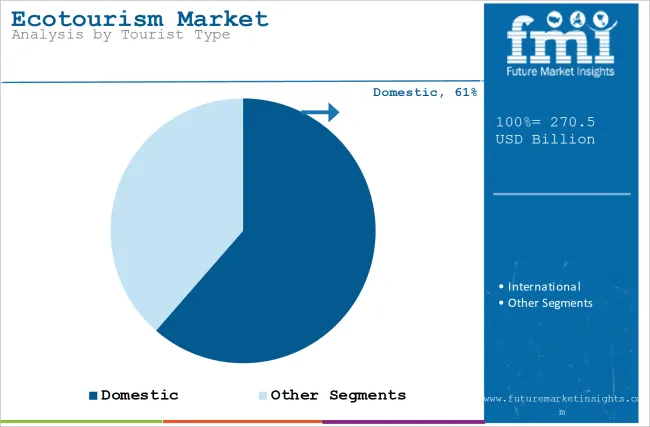As per newly released data, the Ecotourism market is estimated at USD 270.5 billion in 2025 and is projected to reach USD 551.8 billion by 2035, registering a CAGR of 7.4% from 2025 to 2035.
The ecotourism industry has developed into a pivotal segment of the travel and tourism landscape. Defined by its focus on sustainability, conservation efforts, and community participation, it has significantly altered consumer preferences and tourism strategies.
Growing consciousness regarding climate change and the importance of biodiversity conservation has led travelers to pursue more environmentally and socially responsible travel practices. Beginning with the objective of protecting natural ecosystems and engaging local communities in the tourism economy, ecotourism has become a major driver of global tourism, increasingly representing a larger portion of the market.
North America is leading the industry due to its well-developed infrastructure for national parks. The Asia-Pacific region is growing the fastest, driven by factors such as rich biodiversity and supportive government initiatives. Europe remains an important destination that has plenty of cultural and natural attractions combined with sustainability certificates and accommodation.
The Middle East and Africa, although they have a lot of unutilized resources, are rapidly moving toward catching up with the rest of the world in terms of achieving global sustainability objectives.

| Attribute | Details |
|---|---|
| Current Ecotourism Market Size (2024A) | USD 251.2 Billion |
| Estimated Ecotourism Market Size (2025E) | ~USD 270.5 Billion |
| Projected Ecotourism Market Size (2035F) | ~USD 551.8 Billion |
| Value CAGR (2025 to 2035) | ~7.4% |
| Ecotourism Market Top Players Share in 2024 | ~55% to 65% |
Nature and Wildlife Sector Accounts for more than 50% of Ecotourism Industry Revenue
It is expected that the ecotourism sector focusing on nature and wildlife will see considerable growth in the upcoming forecast period, as this type of tourism remains highly favored among individuals. Nature and wildlife enthusiasts are partaking in excursions to rare and endangered environments with the goal of fostering awareness about ecological issues and supporting conservation efforts.
Additionally, nature tourism involves a wide array of adventure activities, such as trekking, hiking, rock climbing, rafting, caving, sailing, bird watching, and swimming.

It is projected that the number of eco-tourists within the 26 to 35 age bracket will increase. This group is likely to shift their travel preferences towards vacations that emphasize sustainability and have a low carbon footprint.
Millennials, as a generational segment, show a heightened consciousness of the need for sustainable tourism practices. There is a notable demand for sustainable lodging alternatives aimed at minimizing the ecological effects of tourism, with those aged 25 to 35 increasingly embracing optimal sustainability practices.

There is a marked preference for international travel among eco-tourists in today's market. The travel and tourism sector is currently rich with easily obtainable tickets for air, rail, and bus travel, as well as a variety of travel packages.
Moreover, a substantial portion of the population is keen to visit overseas destinations to connect with individuals from different cultural backgrounds, nationalities, and belief systems. This interaction not only aids in the learning of new languages and cultural traditions but also promotes the establishment of new relationships.

The statistics accumulated reveal the global ecotourism market has witnessed a significant surge over the past few years. The key stakeholders in the market are in conjunction with the increasing demand for ecotourism. The market performance is expected to remain stable, with the CAGR of 7.4% during 2025 to 2035, as compared to 7.6% during 2020 to 2024.
The observed growth can be ascribed to the heightened international attention on environmental protection, the evolving consumer inclination towards sustainable travel practices, and the establishment of government-supported programs aimed at fostering conservation.
Increasing Consumer Awareness of Sustainability
Global awareness about environmental conservation has increased demand for green travel, which has boosted the ecotourism industry. Unique landscapes, biodiversity, and cultural heritage have driven niche tourism markets globally. Tax benefits, certifications, and national strategies promoting conservation have propelled the sector's growth globally.
Empowering local communities through employment and engagement in ecotourism has created economic and cultural sustainability. Digital resources and apps that promote green travel destinations and options have made it easier for consumers to access eco-tourism services.
Influence of Social Media
Platforms such as TikTok and Instagram are being used by ecotourism staekholders to showcase picturesque eco-destinations and sustainable lodges, inspiring millions of travelers. As an example, the United States has launched the targeted marketing efforts put forth for the emerging markets, mainly targeting Southeast Asia, which has brought a remarkable 35% increase in visitors from this region.
Similarly, the Canadian campaign "For Glowing Hearts" focused on authentic experiences, with a success rate of over 2 billion social media impressions and increased European visitors. This pace continues to propel the market.
Support from Governments is Driving Conservation
Governments across the world are being instrumental in developing the ecotourism sector through several policies. It is done by ensuring that any revenue generated due to tourism is well invested in either conservation or development of the local community. In Costa Rica, for example, tourism income goes into the protection of national parks and biodiversity preservation.
The country's sustainable tourism structure has gained worldwide applause as it could be effectively integrated with economic development without affecting ecological conservation. India is trying to build up its national parks and wildlife sanctuaries, but these have to be sustainable in their nature. Tiger reserve and the Himalayan campaigns are targeted specifically towards environment-conscious tourists.
Technology is Transforming Sustainable Tourism
Technology is playing a pivotal role in advancing sustainability within the tourism industry. Through virtual reality (VR), travelers can engage with eco-friendly destinations without adding to carbon emissions, while mobile applications are promoting accommodations and activities that meet green certification standards. Itineraries designed to reduce environmental impact are being crafted with the assistance of artificial intelligence.
Furthermore, the deployment of solar-powered and electric safari vehicles in protected regions is aimed at diminishing reliance on fossil fuels. In addition, blockchain technology is being utilized in carbon-offset programs to ensure both transparency and effectiveness. These innovations are profoundly enhancing the essence of eco-tourism, leading to increased demand.
Eco-Friendly Lodging Innovations
Increasing investments in renewable energy-powered accommodations to reduce carbon footprints. This also integrates the community-based tourism as well as growth of wellness-centric eco-tourism.
Adoption of Virtual Tourism Tools
VR technologies enabling immersive experiences while reducing environmental impact. Pre-trip Environmental Impact Assessment. Following developments illustrates the reach of VR in ecotourism:
USA Being a Key Destination in Ecotourism has mix of both domestic and international Eco Tourists
The ecotourism sector in the USA is expected to grow 1.5X crossing a valuation of USD82 Billion by 2035 at a CAGR of 4% during 2025 to 2035. The rising awareness of climate change and biodiversity loss has prompted eco-conscious travel to be prioritized.
A survey conducted in 2024 revealed that 68% of American tourists preferred eco-friendly travel options, with 40% willing to pay a premium for certified accommodations and tours. Operators are being compelled to adopt sustainable practices to meet this growing demand.
Untapped ecotourism destinations has proved pivotal towards the market growth in India
The Indian ecotourism industry has slowly gained significant global footprint. New destinations like Meghalaya, the Andaman Islands, and Arunachal Pradesh are offering a huge scope for ecotourism. Joint efforts by NGOs and local governments have ensured that tourism development is linked with conservation.
These areas are now being marketed for community-based tourism, where the focus will be on biodiversity and cultural wealth. With these advancements, the ecotourism industry in India is expected to grow in a double digit CAGR to cross market valuation of USD 41 Billion by 2035.
Rising International Interest in Turkey’s Cultural and Natural Heritage
The ecotourism industry in Turkey is projected to reach a valuation of USD 25 Billion by 2035, growing at a CAGR of 6.9% between 2025 and 2035. The increased interest in Turkey’s biodiversity and cultural richness is being observed among international travelers.
A 2024 survey indicated that 60% of inbound tourists identified nature-based and cultural experiences as their primary travel motivations. Operators are being compelled to expand offerings to include rural homestays, wildlife tours, and heritage site visits.
Environmental Conservation Awareness is increasing in the UK
The UK ecotourism sector is expected to expand at a CAGR of 4.3% during 2025 to 2035. Awareness regarding environmental conservation among UK travelers has been observed to grow significantly. A survey conducted in 2024 revealed that 65% of tourists prioritized sustainability in their travel decisions, and 45% expressed willingness to pay premiums for eco-certified accommodations and experiences. These changing preferences have prompted operators to adopt sustainable practices and promote low-impact travel.
Regional variations define the competitive environment of the ecotourism industry. Large organizations like Intrepid Travel and G Adventures are assuming the market share by enjoying economies of scale and e-abilities. The small firm focuses more on niche markets, for instance, customized services including cultural tours and projects of conservation.
Recent Developments in the Ecotourism Market
| Attribute | Details |
|---|---|
| Forecast Period | 2025 to 2035 |
| Historical Data Available for | 2020 to 2024 |
| Market Analysis | USD Million/Billion for Value |
| Key Regions Covered | North America; Latin America; Europe; South Asia; East Asia; Oceania; MEA |
| Key Segments Covered | Type, Tour Type, Tourist Type, Demography, Age Group |
| Key Companies Profiled | China CYTS Tours Holding; Farm To Farm Tours; Royal Arabian Destination Management; A.C.T. Tours; AAA Travel; AGRILYS Voyages; Agriturismo France; AL VERNETO; Altour; American Express Global Business Travel; Bay Farm Tours; BCD Travel; Big Five Tours & Expeditions Inc; Carlson Wagonlit Travel; China Travel; Corporate Travel Management; Direct Travel; Domiruth PeruTravel; Eco Travel and Tourism LLC; Expedia Group; Ease My Trip |
| Report Coverage | Market Forecast, Company Share Analysis, Competition Intelligence, DROT Analysis, Market Dynamics and Challenges, and Strategic Growth Initiatives |
| Customization & Pricing | Available upon Request |
The global Ecotourism market is estimated to reach a valuation of USD 270.5 billion in 2025.
The global Ecotourism market grew at a 7.6% CAGR between 2020 and 2024.
Leading players operating in the global Ecotourism industry are China CYTS Tours Holding; Farm To Farm Tours; Royal Arabian Destination Management; A.C.T. Tours; AAA Travel; AGRILYS Voyages; Agriturismo France; AL VERNETO; Altour; American Express Global Business Travel; Bay Farm Tours; BCD Travel; Big Five Tours & Expeditions Inc; Carlson Wagonlit Travel; China Travel; Corporate Travel Management; Direct Travel; Domiruth PeruTravel; Eco Travel and Tourism LLC; Ease My Trip; and Expedia Group.
The overall sales of Ecotourism across the USA market are projected to surge at 4.0% CAGR over the forecast period.






Full Research Suite comprises of:
Market outlook & trends analysis
Interviews & case studies
Strategic recommendations
Vendor profiles & capabilities analysis
5-year forecasts
8 regions and 60+ country-level data splits
Market segment data splits
12 months of continuous data updates
DELIVERED AS:
PDF EXCEL ONLINE
UK Ecotourism Market Report – Growth, Demand & Forecast 2025-2035
USA Ecotourism Market Trends – Demand, Innovations & Forecast 2025-2035
India Ecotourism Market Analysis – Demand, Growth & Forecast 2025-2035
Turkiye Ecotourism Market Growth – Trends, Demand & Innovations 2025-2035
Germany Ecotourism Market Insights – Trends, Demand & Growth 2025-2035

Thank you!
You will receive an email from our Business Development Manager. Please be sure to check your SPAM/JUNK folder too.
Chat With
MaRIA